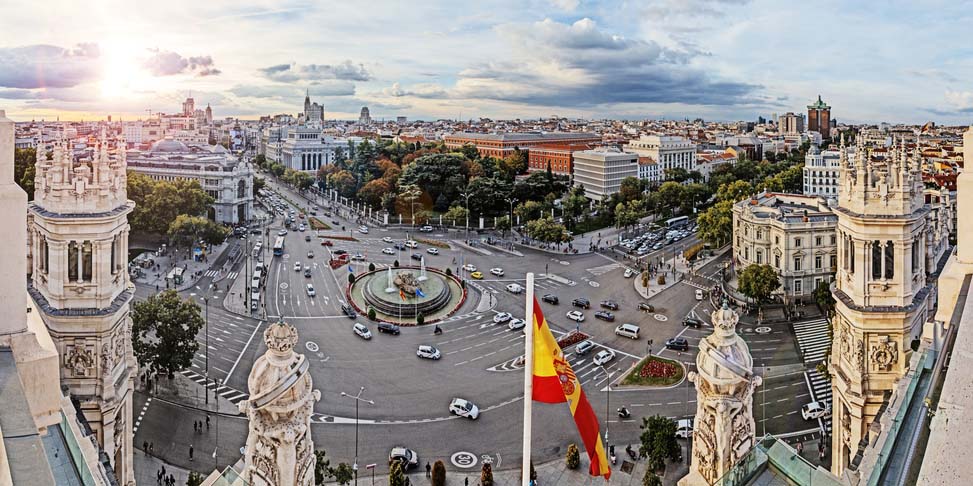
Madrid is the capital of Spain and is located in Spain's smallest autonomous region of the same name. With over three million inhabitants, the city is a vibrant metropolis and an exciting destination for culture vultures and partygoers. The Madrid region has a lot to offer its visitors and is therefore the ideal destination for longer stays, such as a language study trip.
For a successful language study trip to Madrid, the right choice of language school is crucial. Madrid is home to a large number of renowned Spanish schools, which doesn't exactly make the decision any easier. Proven language travel providers organize thousands of language travel programs in Madrid every year and inspire Spanish students time and time again.
The first important criterion when choosing a suitable language school is the range of courses on offer. It is very important that you choose a Spanish school that offers a language course at your learning level. Not every language school in Madrid offers courses at your level and only if you choose a course at your learning level will you be able to make rapid and good progress in the Spanish language. If you would like private lessons, look specifically for schools that offer this. Are you planning a language study trip to Madrid to prepare for the Diploma de Español como Lengua Extranjera (DELE) or do you want to learn industry-specific Spanish? Many, but not all, language schools in Madrid offer diploma courses and Spanish for business or tourism. Some schools offer intensive courses for short stays, others specialize in half-day courses and organize interesting excursions and leisure activities on the side.
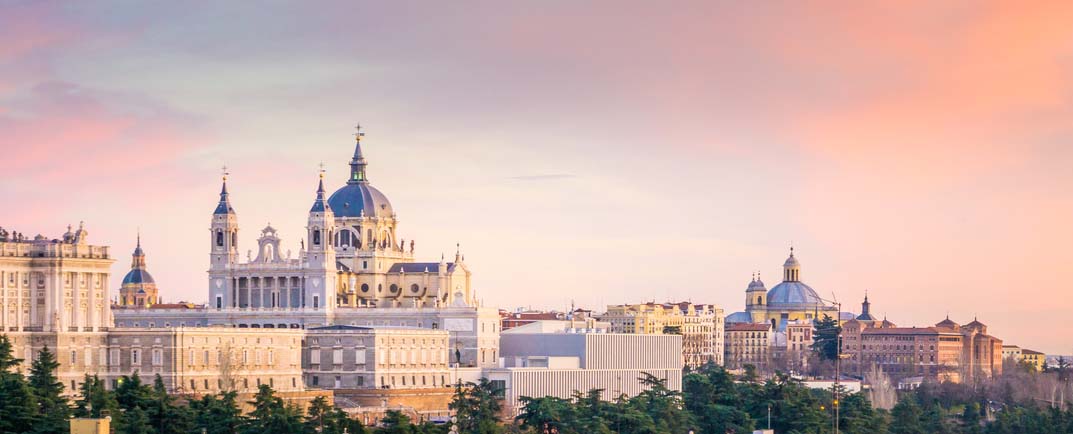
Another factor to consider when looking for the right Spanish school in Madrid is the school's address. For short language study trips in Madrid, you should definitely choose a language school close to the city center, as this way you won't waste time commuting every day - after all, you want to have enough time to get to know the city and have fun in addition to your Spanish lessons. If you go to school and live in the city center, you can explore the city on foot and immerse yourself in the vibrant nightlife in no time at all. A language school and accommodation in the city center are therefore ideal for short language study trips in Madrid. If you want to stay longer in Madrid, you will also find beautiful and quietly located language schools on the outskirts of the city or in the suburbs, which are not in the city center, but close enough for a detour into the center. The relaxed atmosphere outside the hustle and bustle of the city is an ideal balance and a welcome oasis after sightseeing or a night of partying. Life in these districts is slower and creates space for social contacts, you recognize yourself and can quickly make contact with locals and improve your Spanish skills in everyday life. In addition, the cost of living downtown is much higher, so if you live a little further out, you will save money.
Other important points to consider when choosing a language school are the timetables, the number of weekly lessons and the duration of the individual teaching units, the size of the classes and the school itself, the course costs, the nationality mix of the students, the infrastructure, the qualifications of the Spanish teachers and the additional offers such as joint excursions or sports.
We at Ausbildung-Weiterbildung.ch would like to offer you an additional basis for your decision with our informative experience reports from former Swiss language students in Spain. The testimonials of former language students will help you to find the right school for your language travel to Madrid based on the right criteria. The reviews of language schools in Madrid, which you can find via Google if you search for a school via Google Maps, for example, can also provide useful information. The reviews of the individual language schools on Facebook from former language students will also give you a good insight into the quality of the various Spanish schools. You can also find more helpful information, good tips and ideas for your language study trip to Madrid in ourLanguage travel guide.
The language travel agencies and language schools in Madrid generally make every effort to find good accommodation of various kinds.
Host families are a very popular accommodation option during a language study trip. Thanks to the connection to a local family, learning Spanish is almost incidental. The relaxed and informal atmosphere makes it easier for many language students to practise their oral Spanish. Conversations in everyday life, at the dinner table and even on excursions together help students enormously to expand and deepen their Spanish vocabulary. In addition, experiencing the everyday life of the locals is a great enhancement of the language stay, as it provides a unique insight into Spanish culture that would otherwise be denied to many tourists. Host families are also always keen to provide their guests with insider tips on excursions, places to eat and transportation to make their stay a lot more pleasant and uncomplicated. Host families offer single, double or shared rooms and the rooms can be booked without meals, with breakfast only, half board or full board.
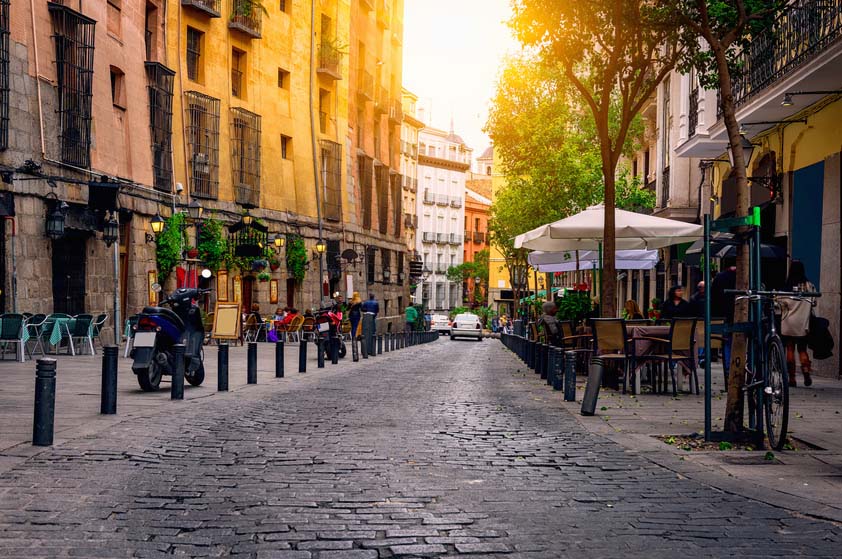
Another accommodation option during a language study trip in Madrid is student residences or shared flats. In most cases, the bathroom and kitchen are shared. If your privacy is very important to you, you can also rent a studio or apartment with its own kitchenette and bathroom. However, these accommodations are usually only rented out for stays of at least a few weeks and are therefore more of an option for longer language stays. The furnishings and quality of the different types of accommodation vary greatly, which results in large differences in rental costs.
Of course, location also plays an important role in choosing the right accommodation. Each district in Madrid has its own unique character. Young people, students and language students prefer the districts of Barrio Salamanca, Chamberí, Malasaña, Moncloa, Palacio or Retiro. It is also important to consider the transport connections to the chosen language school and the city center. Sometimes it's worth paying a little more rent and investing less time and money in commuting. After all, you don't want to waste your valuable time during your language study trip in Madrid in Madrid's heavy traffic or on crowded buses, metros or trains. When staying with a host family, the home address is not given in advance, but only on site. However, the language schools guarantee a maximum distance, which varies between 20 and 45 minutes depending on the school, which makes a big difference. Contact your language school or language travel provider in good time with your ideas and expectations regarding accommodation in Madrid in order to find a suitable solution.
Rumor has it that the nights are longest in Madrid... And you'll believe it after the first few days in the metropolis at the latest. We could add an endless list of recommended bars, clubs and restaurants for all tastes, but we have to limit ourselves to a few top addresses.
If you want to eat well and are looking for something special with a pinch of history, you will find what you are looking for at Botín. The oldest restaurant in the world has been serving satisfied guests since 1725 and therefore has a well-deserved place in the Guinness Book of Records. Another classic and known as the oldest tavern in Madrid is the restaurant Las Cuevas de Luis Candelas, where you can enjoy tapas, grilled dishes and sangria on rustic wooden benches in the caves. The flamenco restaurant El Corral de la Morería offers a special feast not only for the palate but also for the eyes. Prestigious dancers perform here while you indulge in traditional dishes. There is no chance of getting a table here without a reservation.
Various tapas bars throughout the city offer typical Spanish snacks. Special mention should be made of El Txoko, which specializes in Basque tapas and is always very popular in the basement of a Basque house. The Automático has been voted the most popular tapas bar by locals and is located in the lively Lavapiés district, where you can also enjoy outdoor dining in the warmer months.
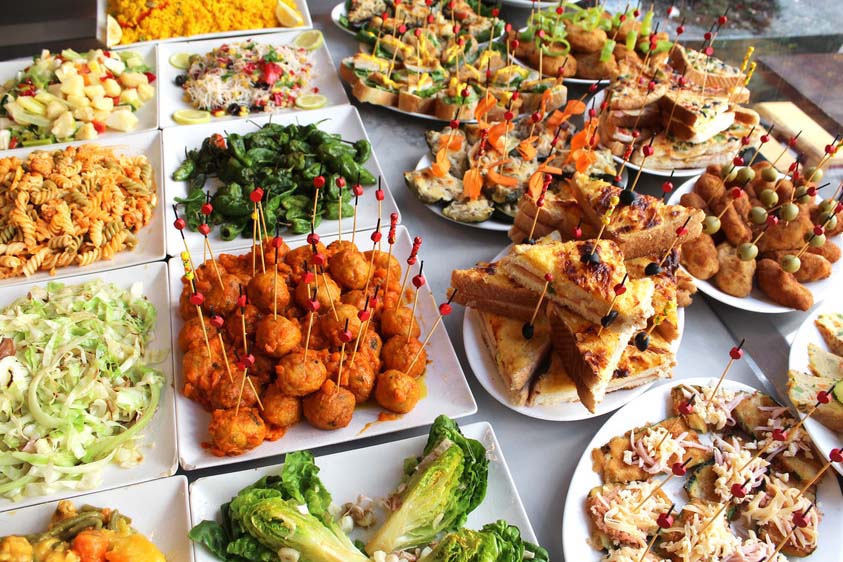
What would a language study trip to the city of longest nights be without dancing? When night falls over Spain, the Plaza Santa Ana district, the center of nocturnal Madrid, comes to life. This is where tourists and locals alike plunge into the nightlife, as the hippest bars and clubs are lined up here. If you prefer something more elegant and upmarket, you will find it in the Retiro and Salamanca districts or in the Castellana area. Cheaper but no less festive nightlife options can be found in the Malasaña district, which is a great place to go out, especially for young students. The Huertas district is home to smaller clubs with various live acts that attract lovers of jazz and salsa.
Here is a list of the hottest clubs in Madrid:
So there will certainly be no lack of party atmosphere during your language study trip to Madrid!
Madrid is known for its numerous renowned museums. The so-called Museum Triangle connects three of the world's most important art museums within a few minutes' walk: The Museo del Prado, the Museo Nacional Centro de Arte Reina Sofia and the Museo de Arte Thyssen-Bornemisza.
The Puerta del Sol square forms the center of both the city itself and the entire country, especially as it connects the six national highways. The Plaza is also a good starting point for Madrid's nightlife, as it is home to some of the most popular nightclubs and bars. The leafy Plaza España is an important destination for fans of modern architecture and meets Gran Vía, Madrid's most famous shopping street. Those who like to watch the hustle and bustle in a street café should make a detour to the Plaza Mayor. The original market square in the middle of Madrid's old town is the liveliest square in the city, where street artists show off their skills and great concerts are held. Plaza Cibeles is also a must-see in Madrid and can be reached via Prado Street. The most famous sights in Madrid are located here: The Cibeles Fountain, the Palacio de las Comunicaciones and the Banco de España.
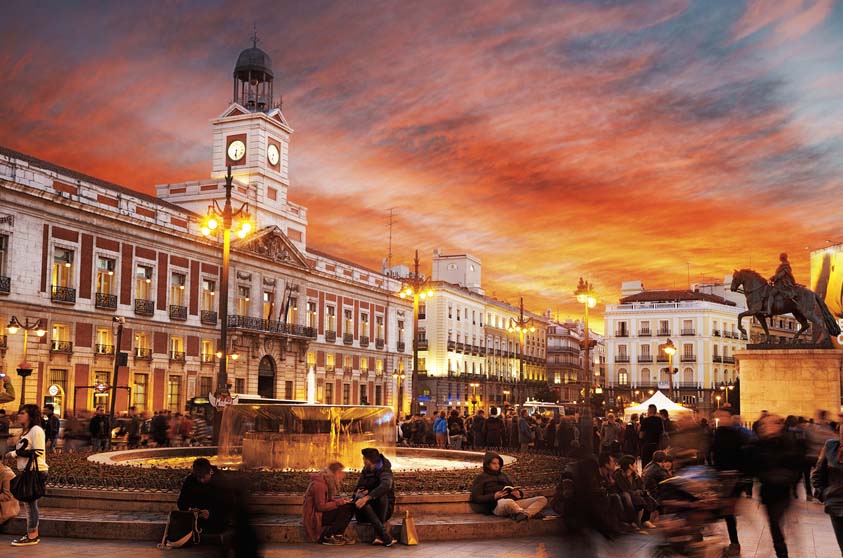
The Palacio Real, the royal palace from the 18th century, is also worth a visit. Pompous architecture and famous paintings can be admired here in the same breath.
The Las Ventas bullring and Real Madrid's Estadio Santiago-Bernabéu and Atlético Madrid's Vicente-Calderón football stadiums are also popular destinations.
If you like to relax in nature, for example to recover from your Spanish course or to study in peace and quiet in the countryside, there are numerous parks and excursion destinations in and around Madrid:
If you would like to take a day trip from Madrid during your language study trip, you can, for example, explore one of the picturesque towns or villages located around Madrid. The historic medieval cities of Salamanca, Ávila, Segovia and Toledo are particularly worth a visit.
The fastest and busiest way to get around Madrid and beyond the city limits is the metro. The very dense and well-developed transportation network of the metro connects numerous important hubs. The metro only stops every day from 2 a.m. to 6 a.m. and runs every 2 to 15 minutes, depending on the time of day. Single journeys cost just over 1 franc. If you use the metro regularly, you can benefit from the Metrobus 10 viajes ticket, the Madrid 10-trip ticket for around 7 francs. The multi-ride ticket is also valid for Madrid's bus services.

The buses in Madrid run daily between 6 am and 10.30 pm. At night, regular night buses transport revelers through the streets of Madrid every 15 to 20 minutes.
If you live in a suburb outside the city during your language study trip in Madrid, you will often travel by train. The trains run from around 4 a.m. until midnight. They are also the ideal means of transportation for excursions to surrounding cities.
If you are staying in Madrid for a longer period of time, you should definitely enquire about the Abono mensual de transporte. This subscription costs just over 40 francs within Madrid's city limits and can be purchased in all Tabaco stores. The subscription is valid for one month for the entire urban transport network of metro, buses and trains.
Cab rides in Madrid cost only a fraction of the price of cab transportation in Switzerland. Nevertheless, this is still the most expensive option and, given the dense transport network in Madrid, is rarely or only rarely a necessary option.
The cost of living in Madrid is relatively affordable compared to other major European cities and is around the middle of the international scale.
However, it should be mentioned here that rents are nevertheless relatively high. A centrally located single room in a shared flat costs around 350 to 550 francs per month. It may be possible to share the monthly rent with a roommate. Somewhat outside the city center, rents cost around 60 francs less per month. Many of these accommodations are dark, damp and cramped. These facts speak in favor of staying with a host family.

The costs for food, going out and everyday things are relatively low in Madrid. In some bars you get free tapas with your drink and even complete menus in average restaurants cost around 12 francs on average.
If you are planning a language study trip to Madrid and want to experience something in this wonderful Spanish city, you should still have a good financial cushion. The cheapest standard course without extras and without private lessons, 20 lessons per week, costs just over 2,000 francs for a month including accommodation. The additional costs for leisure activities quickly add up and who wants to miss out on rhythms, dancing and culinary delights on a language course in the land of flamenco and tapas?